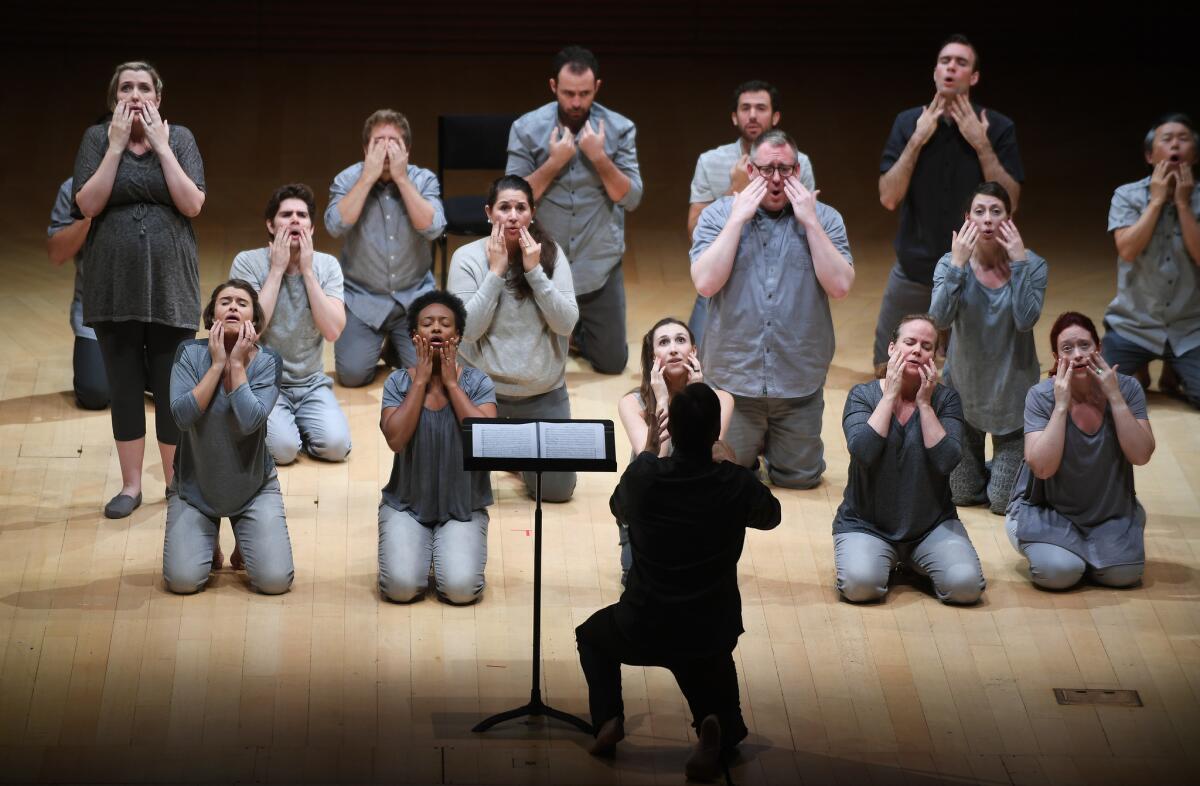Column: Noh theater: The world’s oldest stage tradition is popping up everywhere

- Share via
Japanese Noh theater, according to Penguin Classics’ volume of the plays, “is one of the great achievements of civilization.” Few would dispute that claim, if only because there are so few who could actually evaluate it.
Noh is said to be the oldest surviving theater tradition in practice. It may also be the most obscure. The stylized, chanted, formally choreographed, masked drama has resisted modernization and Westernization for seven centuries.
Yet two of this year’s three most notable new operas are based directly on ancient Noh plays: Japanese composer Toshio Hosokawa’s “Stilles Meer” (Still Sea), which was given its premiere by Hamburg State Opera in January, and Finnish composer Kaija Saariaho’s “Only the Sound Remains” at Dutch National Opera in March. A little digging could likely find but a degree or two of operatic separation in even the third notable opera of 2016, Thomas Adès’ “The Exterminating Angel,” based on Luis Buñuel’s classic film.
Noh has furthermore been popping up here, there and everywhere. A main attraction of last summer’s Lincoln Center Festival, the largest international summer festival in the U.S., was a rare visit from Tokyo by the Kanze Noh Theatre to perform seven works featuring Kiyokazu Kanze, a 26th generation member of the Kanze family of Noh grand masters. Last month, members of the Kongo Noh Theatre in Japan participated in a week-long series of demonstrations and classes at the Claremont Colleges.
Why Noh? Why now?
No (Noh) why. Noh is indirect drama, better suited for posing questions than, like Ibsen or Arthur Miller, positing answers. If we did know why, we wouldn’t need Noh, and clearly, we do.
During recent trips to the Music Center, some aspect of Noh lurked in the Los Angeles Philharmonic, the Los Angeles Master Choral, Los Angeles Opera or Dance at the Music Center. Noh has been a major influence on Robert Wilson, who brings to UCLA this month “Letter to a Man,” a staging of dancer Vaslav Nijinsky’s diaries starring Mikhail Baryshnikov. The label Chimera Music recently began re-releasing Yoko Ono’s records from the 1970s, and they have plenty Noh to know about.
Yet nothing about Noh resonates with modern life, even in Japan. Indeed, the function of Noh is to remove the audience from the everyday. A Buddhist theater of no action, Noh is meant to slow your heartbeat down. You don’t stop to smell the roses in Noh — you simply stop. The subject matter more often than not is the spirit world of mysterious beings who say mysterious things and do mysterious dances as much for themselves as for you.
Most Japanese, having suffered through studying Noh in school, find performances excruciatingly boring, if not downright alienating. This is a subject so arcane that Noh masters, who spend their lives learning the tradition, say they never fully understand it. But those who do fall for Noh become so immersed in its intricacies that it influences every aspect of their lives, their very being becoming Noh.
Athough they can be enacted anywhere, Noh plays are intended for a specially built unpainted wooden stage, bare except for three pine trees on the side. Under it are large bowls to make voices and instruments resonant. (The Japanese allure for fine acoustics goes back a long way.) There are two characters, a chorus and musicians playing drums and flute. Nothing is real. An old man may portray a lovely young girl by wearing a mask that doesn’t fully cover his face and by singing her lines in a deep guttural voice. But if you know how to look, listen and imagine, the slightest movement of the foot sliding just so on the floor, or the slightest lifting of the head just so, making the mask seem to smile or frown depending on the angle and the way it catches the light, can magically create an allusion more powerful than the real thing.
Still, learning to look, hear and listen is next to impossible for most of us. There is little in the way of recordings, audio or video. The language is archaic. Even the Japanese need translations. And performances are rare. The National Noh Theatre in Tokyo typically presents only three or four performances a month in a venue that seats fewer than 600. Try to get a ticket.
The main source for most of us, then, is the large and influential literature about Noh. In “Learning to Kneel,” a new study of how Noh influenced 20th century Modernism in the West, Carrie J. Preston chronicles her experiences as someone trained in classical ballet and as an English professor at Boston University studying Noh in Japan. The discipline required, the pain from hours spent kneeling, the subjection to the will of a master, the straitjacketing of all dance movements, challenge her 21st century beliefs in feminism and academic freedom while at the same time opening her to unsuspected new influences.
That, she understands, had been Noh’s power all along. W.B. Yeats and Ezra Pound in the early 20th century were besotted by Noh. Yeats wrote Noh-style plays, notably “At the Hawk’s Well.” Pound translated Noh plays, and Noh fingerprints are all over his Cantos. Brecht got wind of Noh, and he too wrote Noh-style plays, two of which were turned into short radio operas by Kurt Weill. (The first, “Lindbergh’s Flight,” just opened the St. Louis Symphony’s fall season).
It was a visit to a Noh theater during Benjamin Britten’s 1955 trip to Japan that led to the most famous Noh opera, “Curlew River,” in which he turns “Sumidagawa” (The Sumida River) — about a madwoman seeking her son’s grave and his appearance as a spirit — into a Christian parable play, performed Noh style with Britten’s own compellingly original modernization of Noh music.
Not only have there been newsworthy new productions of “Curlew River” by video artist Netia Jones and choreographer Mark Morris, but Hosokawa’s “Stilles Meer” also turns to “Sumidagawa” as a vehicle to think about power and nature in wake of the 2011 earthquake and tsunami and the Fukushima nuclear power plant meltdown in Japan.
In America, Noh has made no small impression. John Cage had hoped to write “Noh-Opera” as an Asian sequel to “Europeras 1 & 2,” but he died before he could realize the project. Darius Milhaud completed the final version of his Noh-like “Christophe Colomb” at Mills College in Oakland. Traditionalist Hugo Weisgall adapted his 1976 opera, “Jenny, or the Hundred Nights,” from Noh. Los Angeles composer Anne LeBaron is currently composing an opera with characters derived from seven Noh plays.
But it has been with Wilson and Glass that Noh has had the most significant effect. Noh is essentially the inspiration for the two-person entr’actes, called knee plays, in “Einstein on the Beach.” Glass followed “Einstein” with “portrait” operas about Gandhi (“Satyagraha”) and a Pharaoh (“Akhnaten”), both of which are full of Noh devices.
In L.A. Opera’s current production of “Akhnaten,” countertenor Anthony Roth Costanzo slowly gliding across the stage reveals a familiarity with Noh movement. (He no doubt acquired it while recently performing in Kyoto a mash-up of Noh, Kabuki and opera dramatizing the classic Japanese novel “The Tale of Genji,” from which a number of Noh dramas take their plot.)
Another Noh sighting at the Music Center was Peter Sellars’ staging of Orlando di Lasso’s “Lagrime di San Pietro” with the Master Chorale. Sellars was the director of Saariaho’s “Only the Sound Remains” (canceled from last summer’s Ojai Music Festival because of its technical demands). One of the Noh plays Saariaho and Sellars used, “Hagoromo” (The Feather Mantle), concerns a fisherman who steals an angel’s wings. To get them back, she offers a heavenly dance more beautiful than anything a mortal could know. The fisherman mistrusts her motive and gains enlightenment when she tells him there is no deceit in heaven.
Sellars’ “Lagrime” had much in common with Saariaho’s “Sound.” While the 16th century Di Lasso surely knew nothing about Noh, he lived during a golden age of Noh, and his “Lagrime” is a study in overcoming deceit. Sellars staged the sequence of 21 madrigals in which Peter and Jesus deal with Peter’s denying Jesus as a kind of Noh psychodrama, a space in which you try to empty your mind and find yourself. At times, the singers even kneel as though they were Noh players.
Finally, let’s look under the surface of Andrew Norman’s “Play,” the young Los Angeles composer’s most accomplished work to date. The three-part, 40-minute orchestral score was given its premiere by Gustavo Dudamel and the L.A. Phil in a newly revised and presumably final version the last day of October and then taken on tour to San Francisco.
Norman may not have been thinking Noh, but he was thinking about the same issues of control that Preston brings up in “Learning to Kneel.” He uses drums to trigger a response from other instruments, not unlike the way the drums tell or don’t tell Noh performers what to do. And he reaches for a stillness at the center that is just like what Noh asks us to do in opposition to our impossibly busy lives.
Sellars has described Noh as a place in which you can “stop and feel what you actually feel,” as opposed to a Hollywood movie, “ramping you up to feel things you’ve never felt.” An art form frozen in time may just be what we need most in our time when not just the Arctic ice pack but everything feels as though it were melting.
ALSO
Akhnaten as you’ve never seen him: How L.A. Opera delivers Philip Glass’ Egyptian Pharaoh tale
Why music from 1594 still moves us in 2016: The deep meaning of ‘Tears of St. Peter’
Lucinda Childs’ first new dance for her company in 16 years comes with an Arcade Fire connection
More to Read
The biggest entertainment stories
Get our big stories about Hollywood, film, television, music, arts, culture and more right in your inbox as soon as they publish.
You may occasionally receive promotional content from the Los Angeles Times.











